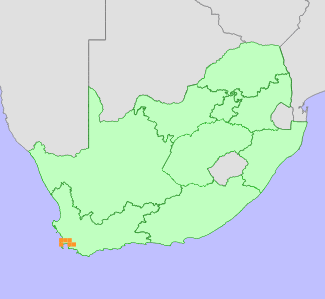|
Scientific Name | Disa longicornu L.f. |
Higher Classification | Monocotyledons |
Family | ORCHIDACEAE |
Synonyms | Disa longicornis Thunb. |
Common Names | Bloumoederkappie (a), Disa (a), Drip Disa (e) |
National Status |
Status and Criteria | Endangered B1ab(v)+2ab(v) |
Assessment Date | 2022/07/07 |
Assessor(s) | N.N. Mhlongo, L. von Staden, E.G.H. Oliver & D. Raimondo |
Justification | This species has a limited distribution range with an extent of occurrence (EOO) of 313 km² and an area of occupancy (AOO) of 44 km². It is known from three locations, comprising very small subpopulations, and the population is declining due to over-collecting and picking. Therefore, it qualifies as Endangered under criterion B. |
Distribution |
Endemism | South African endemic |
Provincial distribution | Western Cape |
Range | This species is endemic to the Western Cape Province of South Africa, where it is found in the Cape Peninsula and Jonkershoek Mountains. |
Habitat and Ecology |
Major system | Terrestrial |
Major habitats | Peninsula Sandstone Fynbos, Kogelberg Sandstone Fynbos, Peninsula Granite Fynbos, Cape Flats Sand Fynbos |
Description | It occurs in partly shaded, moist, south-facing rock ledges and cliffs, near waterfalls or other permanent water sources, 600-1000 m. |
Threats |
| This attractive orchid, with its large conspicuous blue flowers, is threatened by over-collecting and picking, despite its montane habitat. Both mountains on which it occurs are crisscrossed by highly frequented hiking trails (often leading up the gorges where this orchid grows), and according to E.G.H. Oliver, who worked in herbaria in Cape Town and Stellenbosch for many years, 'everyone who sees it collects it.' As subpopulations are generally quite small, over-collecting is causing a decline in population numbers. |
Population |
Some collections indicate only single plants, but can also be locally common (W.R. Liltved, pers. comm.) According to Linder (1981), subpopulations tend to be quite small.
|
Population trend | Decreasing |
Notes |
| Flowering annually in December and January and is not fire dependent. |
Assessment History |
Taxon assessed |
Status and Criteria |
Citation/Red List version | | Disa longicornu L.f. | VU B1ab(v) | Raimondo et al. (2009) | |
Bibliography |
Goldblatt, P. and Manning, J.C. 2000. Cape Plants: A conspectus of the Cape Flora of South Africa. Strelitzia 9. National Botanical Institute, Cape Town.
Liltved, W.R. and Johnson, S.D. Unpublished. The Cape Orchids - Wild orchids of the Cape Floral Kingdom.
Linder, H.P. 1981. Taxonomic studies in the Disinae. III. A revision of Disa Berg. excluding sect. Micranthae Lindl. Contributions from the Bolus Herbarium 9:1-370.
Linder, H.P. and Kurzweil, H. 1999. Orchids of southern Africa. A.A. Balkema, Rotterdam.
Raimondo, D., von Staden, L., Foden, W., Victor, J.E., Helme, N.A., Turner, R.C., Kamundi, D.A. and Manyama, P.A. 2009. Red List of South African Plants. Strelitzia 25. South African National Biodiversity Institute, Pretoria.
|
Citation |
| Mhlongo, N.N., von Staden, L., Oliver, E.G.H. & Raimondo, D. 2022. Disa longicornu L.f. National Assessment: Red List of South African Plants version 2024.1. Accessed on 2025/11/17 |
 Comment on this assessment
Comment on this assessment

